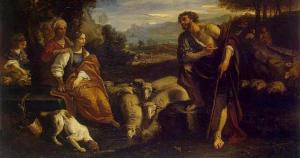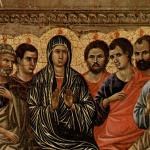This Triduum that just passed, I was abundantly blessed to be able to hear the words of the sacred liturgies with newly attuned ears—ears become familiar, for the first time, with an anthem that the disciples would have known by heart. Recognizing the themes and allusions in Jesus’s words and actions, they would have received a much richer understanding than most of us can glean from our modern perspective and superficial biblical knowledge. And thanks to a most incisive lecture given by my pastor at the start of Holy Week, I was able to catch a glimmer of this understanding for the first time.
The lecture explained the rituals and practice of Jewish betrothal and marriage around the time of Christ, and parallels to the practice of the Eucharist, in particular to John’s Farewell Discourse at the Last Supper. “The wedding feast of the Lamb” may be a familiar concept to many, but I think sharing the details of the entire nuptial process sheds light on a much broader array of Scripture and Christian belief than merely the words of the Last Supper and the institution of the Eucharist. So I have assembled the following description from a variety of Jewish educational sources (avoiding Messianic Jewish and Christian sources in case they contain embellishment to fit the Christian narrative).[1]
Selection of the Bride
The father of a young man would secure a bride for him; it was not (primarily) a bilateral romantic choice of the couple, though ultimately their consent was required to move forward. Either on his own or through a matchmaker or emissary, the first step toward marriage would be the father of the prospective groom seeking the approval of the father of the prospective bride. Women in ancient Israel, and indeed much of the Middle East, were treated as effectively owned by a man and under his headship at almost all times—first their father, then their husband, and finally (if widowed or divorced) a male next-of-kin. As such, the negotiation between the fathers of groom and bride was not simply a request for permission, but involved a purchase price.

In the pre-Talmudic period of Judaism, the groom’s father offered a mohar, a “bride price,” to secure the consent of the girl’s father to hand over mastery of his daughter. (This is the opposite of a dowry, in which the bride’s father hands over property along with his daughter.) In the story of Jacob marrying Rachel and Leah, the mohar was a very substantial 7 years of free labor to their father—for each. Much later in Jewish history, rabbis shifted this practice around, with deterrence of divorce in mind, eventually developing into the ritual of giving the bride a gold ring and signing a ketubah contract, as many Jews practice even today. But in Jesus’s day, the father of the groom likely was still expected to offer a substantial bride price.
Betrothal Ceremony
When the fathers had come to agreement, the groom and the bride would give their consent before at least two competent witnesses, and then celebrate their betrothal in a ceremony called kiddushin, which means consecration, and may also be translated sanctification. (The ceremony is also called erusin, the effect of which is to make the bride-to-be kiddushin: set apart for her groom.) When the couple enters into this covenant, they are effectively considered married, even though cohabitation and sexual consummation are delayed. It was considered adultery to have sexual relations with another while kiddushin, and breaking the betrothal required a formal bill of divorce.
The ceremony, usually performed with the assistance of a rabbi, would begin with pouring a cup of wine, over which the standard blessing of wine would be prayed. (“Blessed are You, Eternal One our God, Ruler of the Universe, Creator of the fruit of the vine.”) Then the betrothal blessing would be spoken by the groom or the rabbi:
Blessed art Thou, O Lord our God, King of the Universe, who has sanctified us by His commandments and has commanded us concerning the forbidden relations, and has forbidden unto us the betrothed and has allowed unto us the wedded through chuppah [the marriage canopy] and kiddushin. Blessed art Thou, who has sanctified His people Israel by chuppah and kiddushin.
The couple would then each drink from the same cup of sanctified wine. The bride-to-be would become referred to as Arusa, a betrothed woman who legally belongs to her husband even though she may still live in her father’s house.
Between the Betrothal and the Nuptial Ceremony
After the betrothal, the man would return to his father’s house, and the woman would stay with her father, or perhaps with friends. This separation would last for a considerable amount of time—usually about a year (or much more if the bride had been betrothed as a young girl, in which case her father would have consented to her betrothal on her behalf). Sexual relations were forbidden during this time, and generally the two would be kept from any direct contact and communication whatsoever. If they needed or desired to communicate, they would need to use an intermediary.
The main purpose of this time of separation was to give the groom-to-be time to prepare a dwelling place for his bride and future family to live in. This was typically built as a sort of addition onto his father’s house. The father of the groom would determine when the dwelling place was ready for the groom to go back to the bride’s home and carry her home with him to complete the marriage.
In the meanwhile, the bride-to-be would sew her wedding garment and make other preparations for the nuptials. These might include having friends with her who would accompany her to the nuptial ceremony, and undertaking a mikvah, a ritual cleansing bath. It was common practice for the groom to arrive without forewarning late at night, so the bride and her friends and family had to be in a constant state of preparedness.
Nuptial Completion
The ritual of taking the bride into the groom’s home is called nissuin, which derives from a word meaning “elevation” or “carry.” This refers to the traditional practice of the bride being carried back to the groom’s dwelling on an elevated platform or carriage. The groom takes the bride under the chuppa, symbolic of bringing her into his home, and they recite seven blessings in the presence of witnesses. They then drink from a blessed cup of wine again.
The couple then retires for little while to a completely private room. Actual sexual consummation is not required at this time for the marriage to be considered complete, but this act is certainly symbolic of that. Then the bride and groom emerge and host an elaborate banquet to celebrate their nuptials.
In medieval times, rabbis began combining kiddushin and nissuin into a single marriage ceremony, separated in time only by the reading of the ketubah contract, and traditional Jewish weddings still combine the elements of these two rituals today. As one source explains, “The kiddushin celebrates a new legal bond in the community; the nissuin celebrates a personal tie.”[2]
When the marriage is complete after the nissuin, the husband has a set of obligations towards and entitlements from his wife. The obligations involve providing for her during the marriage and after the death of one of them (food, clothing, medical expenses, burial, maintenance in widowhood, inheritance for children), paying her a substantial sum if he divorces her, ransoming her if she is taken captive, and providing her with regular sexual relations. In exchange, the husband is entitled to the fruits of her labor, income from the assets she brings to the marriage, and inheriting those assets when she dies. Interestingly, sexual relations is not an entitlement of the husband that the wife owes to him, but an obligation he owes to her.
Christian Implications of Understanding Jewish Marriage Rituals
Many readers are well familiar with explicit marriage imagery contained in the New Testament, such as the parable of the foolish virgins (Mt 25:1-13), the mystery described by St. Paul in Ephesians 5, and the extended description of the wedding feast of the Lamb in the closing chapters of Revelation. This description I have just given of the entire process of betrothal and marriage in ancient Judaism naturally provides additional context to these passages. It also reveals that the Last Supper is a melding of the Passover ritual with the kiddushin betrothal ritual, especially when considering the promise to prepare a dwelling and send an Advocate in John 14.
But one key part of this whole process that I’ve never seen remarked upon by Catholic authors is the significance of the mohar, the bride price. While I intend to explore other avenues of deeper biblical insight from understanding ancient Jewish marriage practices in future posts, for now I will focus on this one.
[See page 2 for footnotes]











